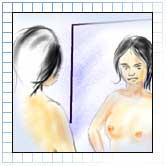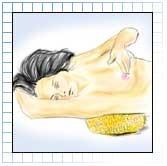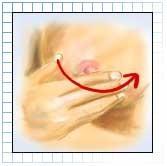Breast Cancer
Breast Cancer
Breast cancer is the most common type of cancer in women, and the second most common cause of cancer death in women. During a woman's lifetime, the risk of breast cancer is approximately 1 in 9.
Symptoms
- Breast lump
- Nipple discharge
- Retracted nipple
- Red/inflamed nipple
- Breast enlargement
- Breast shrinkage
- Breast becomes hard
- Bone pain
- Back pain
Risk factors
- Family history of breast cancer. Mostly among close relatives
- Risk increases as women get older
- Previous incidence of uterine cancer
- Previous breast cancer, atypical changes, and previous breast disease
- Genetic defects or changes (rare chances)
- Menstrual periods started before the age of 12
- Menopause ended after age 50
- No children
- Alcohol, high fat in diet, increased fibre diet, smoking, obesity, and having previous ovarian or
Treatment
Breast cancer treatment depends on three major factors:
- If the woman has reached menopause
- The extent to which the breast cancer has spread
- The cell type of the breast cancer
The extent of the spread of the cancer is defined accordingly:
- Where it is localized in the breast
- The rate of the cancer's spread to the lymph nodes
- The spread of the cancer to deep muscles in the breast
- The spread of the cancer to the other breast
- The spread of the cancer to the other organs, i.e., bone or brain
In terms of cell types, there are more aggressive and less aggressive cell types. In addition, there are receptors on the cells themselves that make breast cancer more responsive to treatment.
Based on the above factors doctors may decide on
- Removal of the lump and local tissue around it with or without radiaotion
- Removal of the entire breast
Prevention
- Monthly self-breast examination
- Yearly breast exams by your physician
- Intake of a nutritious diet
If you suspect having breast cancer, consult the doctor immediately. Breast cancer is curable when treated early but can lead to death if diagnosis and treatment is delayed.
Breast Self Examination
Breast self-exam is an easy and effective tool for early detection of breast cancer.
Who has to do it?
Women of all ages should perform self-examination since breast problems can occur at any age.
When to do a Breast Self Examination?
- Breast Self-Examination is done monthly.
- The best time of the month to perform it is after menstruation, when the breast tissue is softer and lumps are more likely to be felt. For women who are post-menstrual, with irregular periods or who have had hysterectomy, a suitable time should be chosen - for example the 1st day of the month
Materials required
- A pillow
- A mirror
How to do it ?
Step 1:


Stand in front of the mirror. Look for changes in each breast in three different positions - with your hands raised above, with your hands on your hips and with your hands relaxed hanging in front of you. Observe for changes in each of the breast with regard to the following
- Shape
- Size
- Contour or symmetry (is there a difference in the level between your nipples? Do both breasts look symmetrical?)
- Skin discoloration or dimpling
- Bumps/lumps – NOTE: normal lumpiness, like in the week before and of your menstrual cycle, will appear as very small and separate lumps like the texture of an orange.
- Sores or scaly skin
- Discharge or puckering of the nipple
- Dimple
- Ulceration
Step 2:


- Lie flat on a bed and examine every inch of your breast for the presence of lumps.
- Use the left hand for the right breast and right hand for the left.
- Apply firm pressure using the pads of your three middle fingertips to feel for any lumps or bumpy areas.
- To cover the entire breast area including the nipple, examine by following a pattern ie. in a circular way or up and down.
- Extend the examination to the breast tissue in the underarm. Keep moving your hand across the nipple till you feel you have felt all parts of the breast.
- Feel for lumps under and along the top of the collar bone. Change your hand and repeat BSE on the opposite breast.
Source : Tata Memorial Hospital
Related resources
അവസാനം പരിഷ്കരിച്ചത് : 2/20/2020
This topic covers information about Amoebic Liver ...
Basic information on Malaria including symptoms, c...
This topic deals with information related to Anima...
Acne causes, symptoms and remedies are described h...
